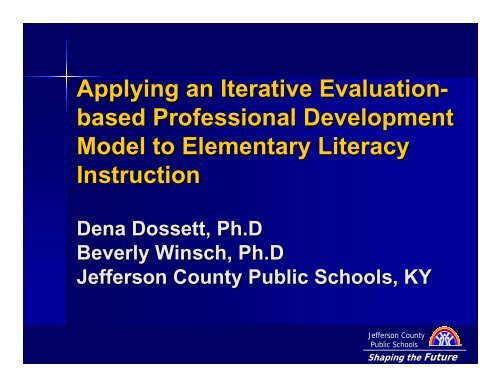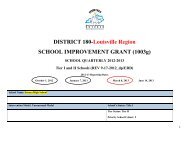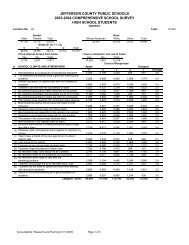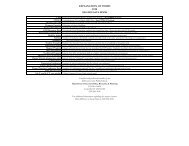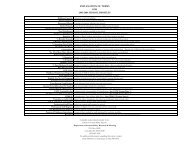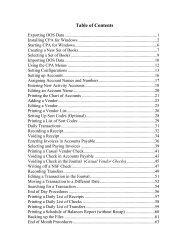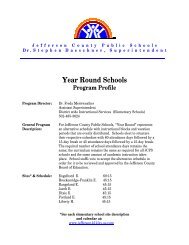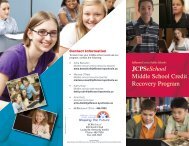Shaping the Future - Jefferson County Public Schools
Shaping the Future - Jefferson County Public Schools
Shaping the Future - Jefferson County Public Schools
You also want an ePaper? Increase the reach of your titles
YUMPU automatically turns print PDFs into web optimized ePapers that Google loves.
Applying an Iterative Evaluation-<br />
based Professional Development<br />
Model to Elementary Literacy<br />
Instruction<br />
Dena Dossett, Ph.D<br />
Beverly Winsch, Ph.D<br />
<strong>Jefferson</strong> <strong>County</strong> <strong>Public</strong> <strong>Schools</strong>, KY<br />
<strong>Jefferson</strong> <strong>County</strong><br />
<strong>Public</strong> <strong>Schools</strong><br />
<strong>Shaping</strong> <strong>the</strong> <strong>Future</strong>
<strong>Jefferson</strong> <strong>County</strong> <strong>Public</strong><br />
<strong>Schools</strong><br />
• 28 th largest school district in U.S.<br />
• 98,000 students (1/7 of all students in KY)<br />
• 153 <strong>Schools</strong><br />
• Preschool……………<br />
3- and 4-year4<br />
year-olds<br />
• K-5 5 (Elementary)…………<br />
………….. 87 schools<br />
• 6-88 (Middle)………………<br />
……………….. 23 schools<br />
• 9-12 (High)…………………<br />
…………………. 20 schools<br />
• Special Education…………<br />
…………. 3 schools<br />
• Alternative/O<strong>the</strong>r…………<br />
…………. 20 schools<br />
<strong>Jefferson</strong> <strong>County</strong><br />
<strong>Public</strong> <strong>Schools</strong><br />
<strong>Shaping</strong> <strong>the</strong> <strong>Future</strong>
<strong>Jefferson</strong> <strong>County</strong> <strong>Public</strong><br />
<strong>Schools</strong><br />
Racial Composition<br />
34% African-American<br />
59% White<br />
7% O<strong>the</strong>r<br />
Non-English Language<br />
Background students<br />
<br />
4,128 (4.2%) students<br />
823% growth since 1990<br />
<br />
40% of State NELB<br />
Exceptional Child<br />
Education<br />
13,595 students ages 3-21<br />
Home/Hospital students<br />
Homeless students<br />
4,600 (5%) students<br />
288% growth since 1993<br />
Single-parent households<br />
54% of total JCPS population<br />
82% of <strong>the</strong> JCPS African-American<br />
population<br />
Free or reduced-price lunch<br />
61% of Elementary students<br />
4% increase since 2002-03<br />
<strong>Jefferson</strong> <strong>County</strong><br />
<strong>Public</strong> <strong>Schools</strong><br />
<strong>Shaping</strong> <strong>the</strong> <strong>Future</strong>
Every 1 Reads<br />
• Every 1 Reads is an education initiative that is<br />
designed to have every JCPS student reading at<br />
grade level within four years.<br />
• This goal will position <strong>the</strong> Louisville Metro<br />
area as a national pacesetter in education.<br />
• Currently, 18,000 students are<br />
not reading on grade level.<br />
<strong>Jefferson</strong> <strong>County</strong><br />
<strong>Public</strong> <strong>Schools</strong><br />
<strong>Shaping</strong> <strong>the</strong> <strong>Future</strong>
JCPS Elementary Literacy<br />
Initiative<br />
Assessment<br />
‣ Diagnostic and achievement tests at each grade level<br />
Curriculum<br />
‣ Established, research-based, standardized instruction<br />
for reading and writing<br />
‣ Prescriptive<br />
‣ Core Content Guides<br />
‣ 38 Literacy coaches<br />
Intervention<br />
‣ Extended School Services<br />
‣ Tier I, II, III (additional time, supplemental materials, accommodations)<br />
<strong>Jefferson</strong> <strong>County</strong><br />
<strong>Public</strong> <strong>Schools</strong><br />
<strong>Shaping</strong> <strong>the</strong> <strong>Future</strong>
JCPS Elementary Literacy<br />
Initiative<br />
Structure<br />
‣ Additional Time<br />
‣ Group, Regroup<br />
Professional Development<br />
‣ Narrow and focused<br />
‣ Long-term<br />
‣ Job-embedded<br />
‣ Data-driven<br />
‣ Research-based<br />
‣ All teachers trained in reading strategies<br />
<strong>Jefferson</strong> <strong>County</strong><br />
<strong>Public</strong> <strong>Schools</strong><br />
<strong>Shaping</strong> <strong>the</strong> <strong>Future</strong>
JCPS Elementary Literacy<br />
Initiative<br />
Assessment<br />
Curriculum/<br />
Instruction<br />
Intervention<br />
Professional<br />
Development<br />
Data<br />
Management<br />
System<br />
Diagnostic/<br />
Achievement<br />
tests at each<br />
grade level<br />
School-Based<br />
Analysis of<br />
Student Work<br />
5 Block Model:<br />
Community Reading &<br />
Conversation<br />
Guided Reading<br />
Word Work<br />
Writing<br />
Self-Selected Reading<br />
Teacher Resource<br />
Materials, School and<br />
Classroom Materials<br />
Tier 1<br />
5 Block Literacy Model<br />
150-180 Minutes<br />
Tier 2<br />
Accommodations &<br />
Supplemental<br />
Materials (during<br />
Tier 1 instruction)<br />
Earobics<br />
Comprehension Plus<br />
Tier 3<br />
Reading Recovery<br />
Reading Mastery<br />
District Based<br />
Summer<br />
Institute<br />
School Based<br />
Sessions<br />
<strong>Jefferson</strong> <strong>County</strong><br />
<strong>Public</strong> <strong>Schools</strong><br />
<strong>Shaping</strong> <strong>the</strong> <strong>Future</strong>
JCPS Professional<br />
Development Model<br />
TASK: Develop an Effective JCPS<br />
Framework that Links <strong>the</strong> Impact<br />
of PD to Student Achievement<br />
Issue 1: JCPS needs to standardize district-wide<br />
professional development<br />
Issue 2: Empirical connections between training<br />
and student achievement need to be<br />
established<br />
<strong>Jefferson</strong> <strong>County</strong><br />
<strong>Public</strong> <strong>Schools</strong><br />
<strong>Shaping</strong> <strong>the</strong> <strong>Future</strong>
JCPS Professional<br />
Development Model<br />
E<br />
V<br />
A<br />
L<br />
U<br />
A<br />
T<br />
I<br />
O<br />
N<br />
Stage Stage 1: 1:<br />
ANALYSIS ANALYSIS<br />
Stage Stage 2: 2:<br />
DEVELOPMENT<br />
DEVELOPMENT<br />
Stage Stage 3: 3:<br />
DELIVERY DELIVERY<br />
Stage Stage 4: 4:<br />
IMPLEMENTATION<br />
IMPLEMENTATION<br />
Needs<br />
Objectives<br />
Format<br />
Evaluation Tools<br />
Instruction<br />
Piloting<br />
Operational Training<br />
-Participant Reaction<br />
-Participant Knowledge<br />
Prep for School-Based Evaluation<br />
Organization Support/Change<br />
Participant Use of New<br />
Knowledge and Skills<br />
Student Learning Outcomes<br />
<strong>Jefferson</strong> <strong>County</strong><br />
<strong>Public</strong> <strong>Schools</strong><br />
<strong>Shaping</strong> <strong>the</strong> <strong>Future</strong>
Advantages of <strong>the</strong> JCPS<br />
PD Model<br />
• Requires Deliberate, Purposeful Training<br />
Development<br />
• Uses Proven Instructional Design Principles<br />
• Standardizes PD Presentations<br />
• Generates Meaningful Evaluation Data<br />
• Results in Reusable Training Support Packages<br />
(TSPs)<br />
• Embeds Quality Assurance Process<br />
<strong>Jefferson</strong> <strong>County</strong><br />
<strong>Public</strong> <strong>Schools</strong><br />
<strong>Shaping</strong> <strong>the</strong> <strong>Future</strong>
Organizational Support<br />
for <strong>the</strong> JCPS PD Model<br />
Inter-Disciplinary PD Panel with Expertise in:<br />
•Evaluation<br />
•Professional Development<br />
•Curriculum<br />
•School Support<br />
•Literacy<br />
•Assessment<br />
<strong>Jefferson</strong> <strong>County</strong><br />
<strong>Public</strong> <strong>Schools</strong><br />
<strong>Shaping</strong> <strong>the</strong> <strong>Future</strong>
E<br />
V<br />
A<br />
L<br />
U<br />
A<br />
T<br />
I<br />
O<br />
N<br />
JCPS Professional Development Process Flowchart<br />
Evidence<br />
insufficient<br />
Evidence<br />
insufficient<br />
Unfavorable<br />
evaluation<br />
results<br />
Content Expert/PD Panel Member conduct<br />
Stage 1: Analysis<br />
•Needs Assessment<br />
•Measurable Goals<br />
•Skills<br />
•Format<br />
PD System Committee(includes PD Panel<br />
member(s)) reviews analysis evidence<br />
Content Expert/PD Panel Member conduct<br />
Stage 2: Development<br />
•Measurable Objectives<br />
•Evaluation Tools<br />
•Instruction<br />
•Pilot TSP<br />
PD Panel reviews development evidence<br />
PD Presenter conducts Stage 3: Delivery<br />
• Operational delivery<br />
• Preparation for school based evaluation<br />
Content Experts review levels 1 and 2<br />
evaluation results<br />
PD Participant conducts<br />
Stage 4: Implementation<br />
Principal conducts Level 4 evaluation and with<br />
outside validation conducts levels 3 & 5<br />
Content Experts review level 3-5<br />
evaluation results<br />
Evidence<br />
sufficient<br />
Evidence<br />
sufficient<br />
Favorable<br />
evaluation<br />
results<br />
<strong>Jefferson</strong> <strong>County</strong><br />
<strong>Public</strong> <strong>Schools</strong><br />
<strong>Shaping</strong> <strong>the</strong> <strong>Future</strong>
Major Outcomes of JCPS<br />
PD Model<br />
Stage 1: Analysis<br />
Multiple Data Sources Indicated an Implementation Issue with Teachers<br />
Delivering Guided Reading Instruction to Elementary Students.<br />
Stage 2: Development<br />
Created Professional Development Job Aid for Training Developers based<br />
on PD Model.<br />
Held Workshops with District Literacy Specialists who began TSP<br />
Development Process.<br />
Fur<strong>the</strong>r Analyses Revealed that <strong>the</strong> Classroom Organizational Support<br />
Systems/Materials for Guided Reading Instruction were Inadequate.<br />
Selected a guided reading program compatible with <strong>the</strong> major tenets of<br />
<strong>the</strong> PD model<br />
<strong>Jefferson</strong> <strong>County</strong><br />
<strong>Public</strong> <strong>Schools</strong><br />
<strong>Shaping</strong> <strong>the</strong> <strong>Future</strong>
Major Outcomes Continued<br />
Stage 3: Delivery<br />
1400 teachers attended guided reading institute. Training topics<br />
included assessment, guided reading, shared reading, classroom<br />
management, and explicit strategy instruction<br />
All training was standardized. Collected participant reaction and<br />
knowledge data<br />
Established plan to measure 5 levels of evaluation of guided<br />
reading professional development institute<br />
<strong>Jefferson</strong> <strong>County</strong><br />
<strong>Public</strong> <strong>Schools</strong><br />
<strong>Shaping</strong> <strong>the</strong> <strong>Future</strong>
Five Levels of Professional<br />
Development Evaluation*<br />
Level 1 - Participants’ Reactions<br />
Level 2 - Participants’ Learning<br />
Level 3 - Organization Support & Change<br />
Level 4 - Participants’ Use of New<br />
Knowledge & Skills<br />
Level 5 - Student Learning Outcomes<br />
*Adapted from Guskey, T.R. (2002) Evaluating Professional<br />
Development. Thousand Oaks, CA: Corwin Press<br />
<strong>Jefferson</strong> <strong>County</strong><br />
<strong>Public</strong> <strong>Schools</strong><br />
<strong>Shaping</strong> <strong>the</strong> <strong>Future</strong>
Level 1 Evaluation:<br />
Participants’ Reactions<br />
Purpose<br />
Evaluation<br />
Question<br />
Data Collection<br />
Method<br />
Outcome<br />
Implication<br />
To measure participants’ reactions/ satisfaction with <strong>the</strong><br />
professional development experience<br />
Did <strong>the</strong> participants understand <strong>the</strong> training materials and<br />
find <strong>the</strong>m useful?<br />
Questionnaires administered at <strong>the</strong> end of <strong>the</strong> guided<br />
reading PD institute<br />
The percentage of participants responded as follows:<br />
85% - extend content knowledge and professional practices<br />
95% - materials were appropriate<br />
93% - information was relevant to classroom<br />
94% - likely to what <strong>the</strong>y have learned in <strong>the</strong>ir classroom<br />
Results used to improve program design and delivery of<br />
follow-up training sessions<br />
<strong>Jefferson</strong> <strong>County</strong><br />
<strong>Public</strong> <strong>Schools</strong><br />
<strong>Shaping</strong> <strong>the</strong> <strong>Future</strong>
Level 2 Evaluation:<br />
Participants’ Learning<br />
Purpose<br />
Evaluation<br />
Question<br />
Data Collection<br />
Method<br />
Outcome<br />
Implication<br />
To measure participants’ new knowledge and skills<br />
Did <strong>the</strong> participants meet <strong>the</strong> presenters’ expected<br />
performance criteria (training objective)?<br />
Questionnaire; Product Demonstrations at end of PD<br />
session<br />
91.8% of participants were judged as meeting <strong>the</strong><br />
expected performance criteria for <strong>the</strong> end of session<br />
Results used to improve program content, format, and<br />
organization<br />
<strong>Jefferson</strong> <strong>County</strong><br />
<strong>Public</strong> <strong>Schools</strong><br />
<strong>Shaping</strong> <strong>the</strong> <strong>Future</strong>
Level 3 Evaluation:<br />
Organization Support & Change<br />
Purpose<br />
Evaluation<br />
Question<br />
Data Collection<br />
Method<br />
Implication<br />
To measure <strong>the</strong> organization’s s capacity, support and facilitation<br />
of <strong>the</strong> implementation of participant’s s new knowledge and skills<br />
Did <strong>the</strong> training affect organizational climate and procedures?<br />
Were sufficient resources made available?<br />
Was implementation facilitated and supported?<br />
Questionnaires of principal, instructional coaches, literacy lead<br />
teachers, literacy teachers<br />
High Ratings Low Ratings<br />
PD supports school goals Financial Support<br />
Quality follow-up support Encouraging PD through<br />
Access to expertise incentives & resources<br />
Sufficient leadership & Collaboration in planning PD<br />
collegial support<br />
Results used to document and improve organization support<br />
<strong>Jefferson</strong> <strong>County</strong><br />
<strong>Public</strong> <strong>Schools</strong><br />
<strong>Shaping</strong> <strong>the</strong> <strong>Future</strong>
Level 4 Evaluation:<br />
Participants’ Use of New Knowledge & Skills<br />
Purpose<br />
Evaluation<br />
Question<br />
Data<br />
Collection<br />
Method<br />
Outcome<br />
Implication<br />
To measure <strong>the</strong> degree and quality of implementation of<br />
participants’ use of new knowledge and skills<br />
Did participants effectively apply <strong>the</strong> new knowledge and<br />
skills?<br />
Classroom observations of guided reading lessons using 4<br />
point rubric conducted by instructional coaches twice a year<br />
and monthly by principals<br />
Baseline data:<br />
64% of primary level classrooms at full implementation<br />
51.3% of intermediate level classrooms at full implementation<br />
Results used to document and improve <strong>the</strong> implementation<br />
<strong>Jefferson</strong> <strong>County</strong><br />
<strong>Public</strong> <strong>Schools</strong><br />
<strong>Shaping</strong> <strong>the</strong> <strong>Future</strong>
Level 5 Evaluation:<br />
Student Learning Outcomes<br />
Purpose<br />
Evaluation<br />
Question<br />
Data Collection<br />
Method<br />
Outcome<br />
Implication<br />
To measure <strong>the</strong> impact of PD on student achievement<br />
in reading<br />
What was <strong>the</strong> impact on student reading performance?<br />
Developmental Reading Assessment (administered 2<br />
times a year for all students, 3 times for struggling<br />
readers)<br />
Baseline: 48.1% of students met benchmark<br />
Current: 61.7% of students met benchmark<br />
Results used to improve teacher implementation and<br />
demonstrate <strong>the</strong> impact of teacher PD on student<br />
achievement<br />
<strong>Jefferson</strong> <strong>County</strong><br />
<strong>Public</strong> <strong>Schools</strong><br />
<strong>Shaping</strong> <strong>the</strong> <strong>Future</strong>
Next Steps:<br />
• Level 1 and 2 evaluation data from <strong>the</strong> summer institute in<br />
guided reading will shape follow-up training during <strong>the</strong> school<br />
year<br />
• Level 3 data on organizational support from o<strong>the</strong>r key<br />
stakeholders will be collected and analyzed<br />
• Level 4 data on implementation will be collected in December<br />
and May<br />
• Level 5 student outcome data will continued to be analyzed<br />
during school year<br />
• PD panel will update and extend PD model<br />
• Evaluation of Guided Reading PD will be integrated with o<strong>the</strong>r<br />
evaluation efforts (implementation & outcome) of larger<br />
literacy initiative<br />
<strong>Jefferson</strong> <strong>County</strong><br />
<strong>Public</strong> <strong>Schools</strong><br />
<strong>Shaping</strong> <strong>the</strong> <strong>Future</strong>


